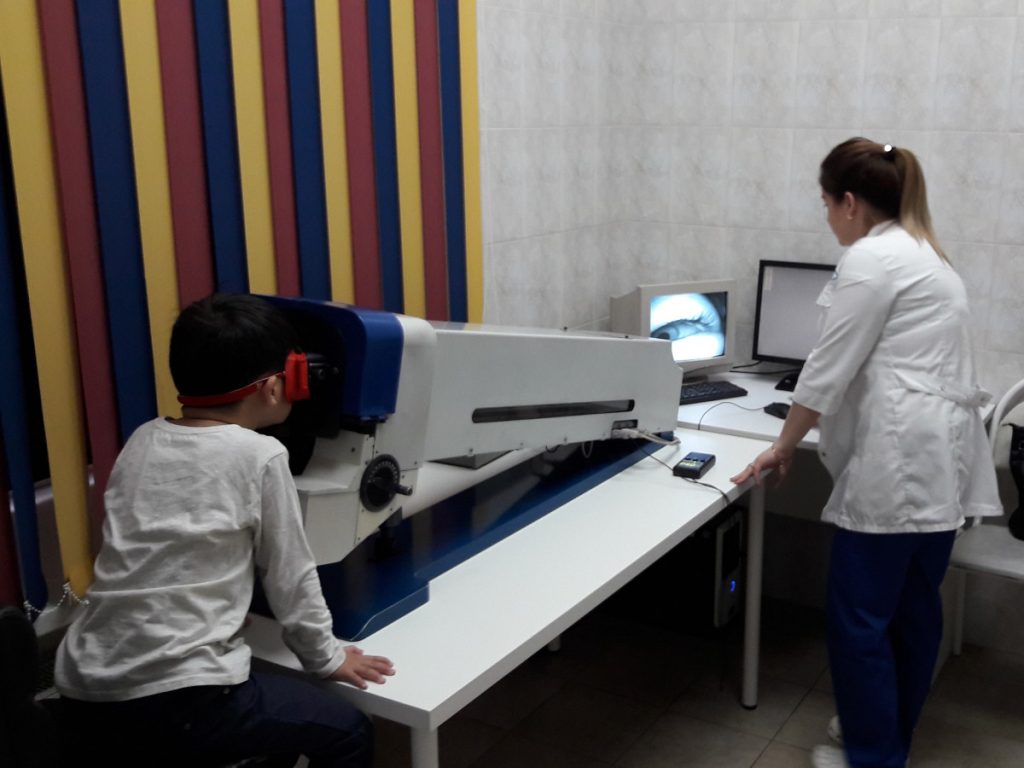Amblyopia in children is a common cause of persistent visual impairment, which may become irreversible if not treated timely. Amblyopia is not an independent disease, it occurs after many ophthalmological issues.
Amblyopia, which is often called "lazy eye," is a condition of vision when one or both eyes did not develop enough in early childhood, and very distorted and limited information comes to the brain from the eyes, thus, visual acuity remains reduced even when wearing glasses.
Often, the pathology is not identified timely since the child sees well with one eye.
In 99% of cases, we may save the child from amblyopia. The technologies we use allow not only restoring vision, but we can also save the child from glasses addiction!

A new high-tech method of treating amblyopia, developed and put into practice in the network of Yasny Vzor children's eye clinics, is the use of Binocular Optometry Complex (BOC-1). This technique has been successfully used by us for more than 7 years. With the help of the BOC-1 device, it is possible to cure amblyopia even in cases when only 1-2% of vision remains. At the same time, the speed of rehabilitation increases by 4 times compared to other, less effective, methods of treatment of amblyopia.
If there was a problem with lazy eyes, treatment of adults was considered impossible, but thanks to BOC-1, even patients aged over 32 years can be cured of this disease. As a result, patients' vision is restored to such an extent that they refuse to wear glasses.
Depending on the type of amblyopia, the speed of rehabilitation varies from a few days to a year. In the latter case, it is required to conduct 3-4 courses per year.
It is important to understand that it is impossible to cure amblyopia, any of its varieties, using a narrow approach, glasses correction only, occlusions only, or one hardware method only. This approach is outdated and inefficient! Only complex regular treatment, only constant dynamic follow-up by a child's ophthalmologist, and the ability to correct and prescribe the required procedures, techniques, and their combination at a given time will help to achieve a sustainable result.
Laser correction of amblyopia is prescribed in the case of anisometropia. This operation surgery does not eliminate amblyopia but eliminates the optical cause of its occurrence. Therefore, the usual conservative treatment of amblyopia is subsequently performed under regular follow-up by an ophthalmologist.
Undue or irregular treatment may cause complications of amblyopia. The most dangerous of them is irreversible vision loss. This condition will require correction with glasses or lenses for the rest of the child's life, while the visual acuity in glasses will not improve. Amblyopia worsens the perception of the surrounding world, may cause failures at school, as well as the child's isolation or problems with socialization.
Prevention of amblyopia consists in eliminating its causes, treatment of strabismus, correction of visual acuity, operations of congenital cataracts, drooping eyelid (eyelid ptosis), etc.
The main thing in the prevention of amblyopia is regular examinations by an ophthalmologist, starting from the first months of the child's life. Amblyopia is well treatable in children under 7 years of age since the visual system is not yet fully formed. When diagnosing the first signs of this disease, it is required to contact an ophthalmologist and follow all its recommendations.
For the diagnosis of amblyopia, it is required to contact specialized centers and to carry out the following examinations:
It is required to exclude other hard-to-diagnose causes of vision loss. The following is conducted for this purpose:
Amblyopia disappears with age. If the child has strabismus or there are other causes why one eye "works" more actively than the other, the resulting amblyopia will not disappear itself.
Amblyopia is treated with the constant use of glasses. Often, the treatment allows correcting the vision, and it is possible to refuse to wear glasses.